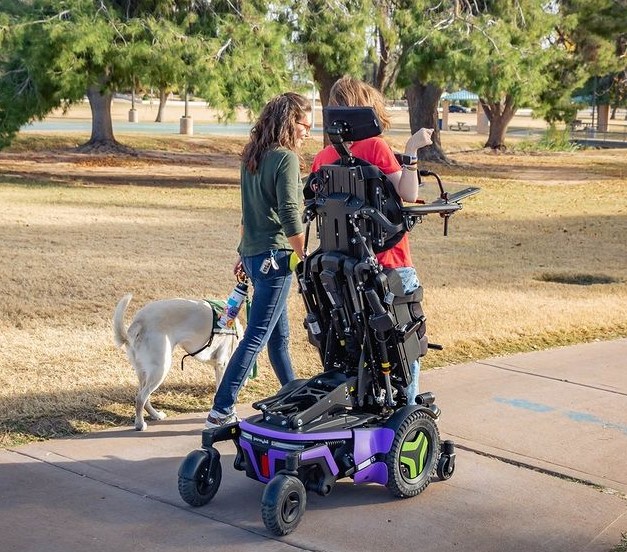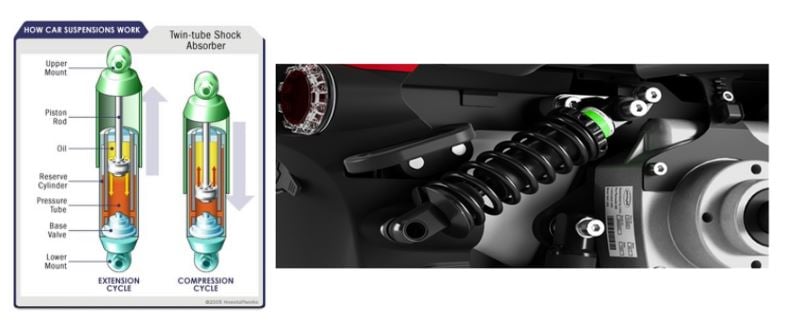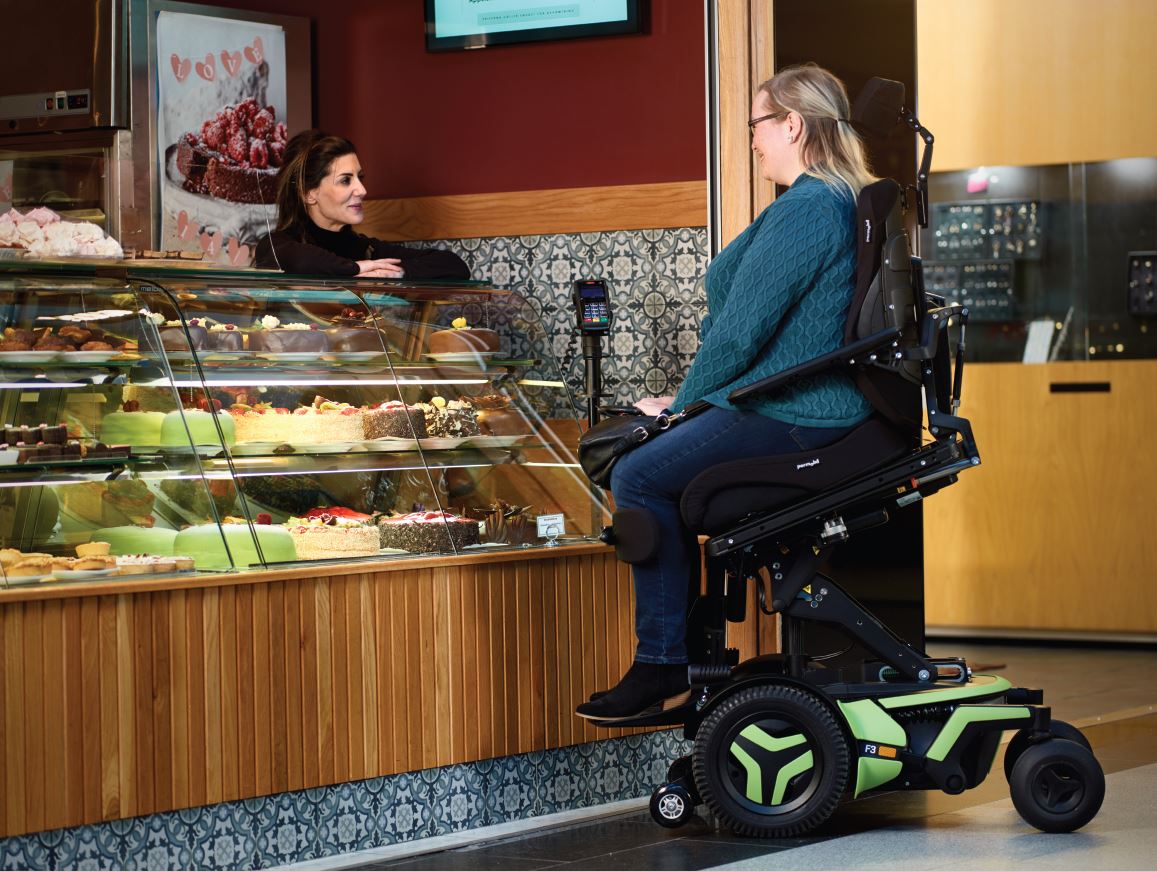This fine line, or the dance between scripting what is going to maximise your client’s function, mobility and positioning and what is deemed reasonable and necessary by a funding body; can at times be very difficult. Add onto this the high number of products available, it makes prescribing appropriate equipment even more difficult! When these factors collide, it is understandable that we all have preferred equipment that we go to first and find these items easier to script as they are familiar. However, this can result in an over prescription or miss prescription of equipment.
Power Wheelchairs (PWC) are an Assistive Technology (AT) item, which historically I found daunting to prescribe. Not only can the price tag be as high as a new car, but compared to prescribing a manual wheelchair, a lot of what we are prescribing can be hidden under the shroud.
Recently, I was asked to break down the differences between our 3-Series PWCs and 5-Series PWCs and asked to outline the key clinical differences between these chairs. These differences have the potential to provide a significant functional outcome for your client. As a result, I wanted to share the following clinical concepts to consider when comparing PWCs: Ride comfort and stability, power, ride position and power seat functions. I hope that these concepts will help you to compare apples with apples and can see how small differences can make a big difference to your client (and the funding body), and that bigger and more does not always mean best for your client.
At the end of this three-part series, I hope that scripting PWCs will be less daunting. I will also happily share the functional comparison document outlining the difference between the 3 Series and 5 Series chairs.
Ride comfort and stability
When talking about power wheelchairs, suspension is a term which we use when comparing chairs, however not all suspension is created equal. Instead of talking about suspension I would encourage you to use the terms ride comfort and stability. These are the functional aspects of what suspension does and the impact it has on the person seated in the chair. Ride comfort and stability are the functional “so what” of suspension.
Prescribing a wheelchair with a high level of suspension can have a positive impact on a client’s health and wellbeing. Good suspension can decrease the risk and experience of tone, pain and fatigue, as there is less vibration and movement experienced by the client when seated. It is the suspension that provides improved ride comfort and stability. A suspension system can differ greatly between chairs and is made up of the tyres, tyre air, springs, shock absorbers and linkages. Together this system absorbs the vibration resulting in stability and improved ride comfort for the client. The final element of suspension is road holding which relates to how well the wheels maintain contact with the ground. This is important for your client as not only for keeping the wheels on the ground contribute to a stable and comfortable chair, but it contributes to improved climbing abilities and thus increasing environmental access.

Consider where your client is going, what type of environment they are climbing and what amount of movement they can tolerate in their seat. What is clinically appropriate for your client? Do consider what your client requires functionally to meet their goals, and be mindful to script what they need, this will enable you to stay within the means of reasonable and necessary whist maximising your client's participation and goal achievement.
How do you work out what good ride comfort and stability looks like? Break down each chair and find out what the suspension is made from. How many coils are there and what are they made from? Where are they located and what wheel/s are they targeting? Are they polymers, is their oil dampening? Springs made from polymer compositions assist to dampen the vibration felt by the client when the front castors pass over obstacles. Oil dampening is where the suspension spring sits in a case of oil and the oil controls the extension phase of the spring. The oil absorbs the energy of the spring which lessens the intensity of the “bounce up”. This improves the ride quality and movement experienced by the client sitting in the chair.
 Do not forget, suspension which contribute to ride comfort is more than just springs and coils. Front wheel drive (FWD) and Rear wheel drive (RWD) PWCs have four wheels, but Mid wheel drive (MWD) PWCs have six wheels! Ride comfort also refers to road holding. The more independent the wheels are of each other, the smoother and better the ride, as it is more likely for all four (or six) wheels remain on the ground. Consider how these things will impact your client, their function and mobility throughout the day.
Do not forget, suspension which contribute to ride comfort is more than just springs and coils. Front wheel drive (FWD) and Rear wheel drive (RWD) PWCs have four wheels, but Mid wheel drive (MWD) PWCs have six wheels! Ride comfort also refers to road holding. The more independent the wheels are of each other, the smoother and better the ride, as it is more likely for all four (or six) wheels remain on the ground. Consider how these things will impact your client, their function and mobility throughout the day.
Watch our suspension video below
I hope that you now think about suspension a little differently when prescribing your next PWC. In part two of this blog, I will dive into power. What contributes to the motors and is bigger better? Stay tuned!

Tilly Brook
Clinical Services Specialist
Permobil APAC
Tilly Brook graduated from the University of Adelaide in 2008 with a Bachelor of Health Science followed by a Masters of Occupational Therapy (Hons) in 2010 from the University of Sydney. Tilly worked within rehabilitation, working primarily with adults with a brain injury until 2015 when she moved to Singapore. In Singapore, she worked with children and adults at the Cerebral Palsy Alliance School (CPAS). In 2017 Tilly’s clinical knowledge continued as she worked with Mobility Solutions in Auckland, New Zealand. On her return to Australia, Tilly assisted in the development of the Clinical Hub Team at Sunrise Medical where her passion and experience for mentoring and educating therapists grew. Tilly Joined Permobil in January 2022 and is driven to grow therapists, enabling them to be the best therapist they can be.
